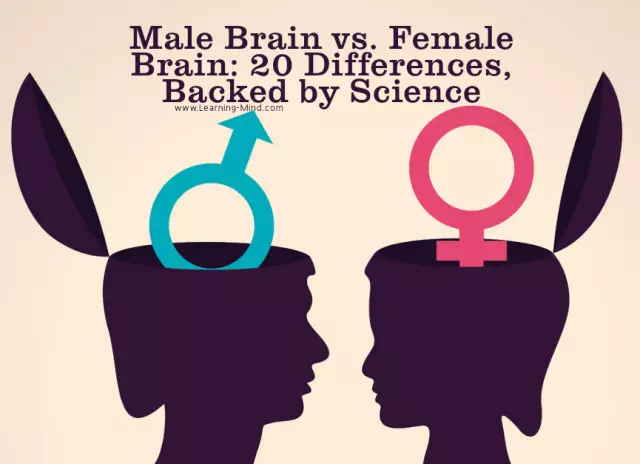- Author Rachel Wainwright [email protected].
- Public 2023-12-15 07:39.
- Last modified 2025-11-02 20:14.
Residual encephalopathy
The content of the article:
- Causes and risk factors
- Symptoms
- Diagnostics
- Treatment of residual encephalopathy
- Possible complications and consequences
- Forecast
- Prevention
Residual encephalopathy (from Latin residuus remaining and other Greek ἐγκέφαλος - brain + πάθος - disease) is a pathology of the central nervous system associated with destructive changes in the brain tissue. Residual encephalopathy is characterized by a delayed appearance of the first symptoms, i.e., the clinical picture of the disease can manifest itself after a long period of time after damage to the nervous tissue of the brain.

Source: golmozg.ru
Causes and risk factors
Destructive processes develop under the influence of various factors. Infectious, endocrinological, somatic diseases or toxic lesions lead to disruption of the structure of the nervous tissue, a significant decrease in its volume. Brain cells are deficient in nutrients and oxygen, which leads to a decrease in the number of active neurons. The brain ceases to function normally, cells with damaged structure undergo programmed death (apoptosis).
Residual encephalopathy can occur as a result of exposure to negative factors during intrauterine development, damage to it during childbirth (fetal hypoxia, birth trauma), against the background of violations of the uteroplacental blood flow, under the influence of infections transferred during pregnancy, chronic somatic diseases of the expectant mother. The impact of aggressive environmental factors and poor ecology can also have negative consequences. If signs of congenital brain damage in a child appear only after some time, we are talking about residual encephalopathy.
Acquired residual encephalopathy is formed under the influence of internal processes and environmental factors that cause damage to brain cells:
- traumatic brain injury (concussion, intracranial hematoma, bruises);
- acute and chronic disorders of cerebral circulation (thrombosis of the sinuses of the dura mater, strokes), intracranial hypertension;
- atherosclerosis, post-stroke condition;
- inflammatory diseases of the nervous tissue of the brain (encephalitis, abscess, meningitis);
- chronic hypoxia of the brain;
- exposure to chemical, neurotropic substances, salts of heavy metals (especially lead), barbiturates, toxins of some fungi and bacteria, carbon monoxide, poisonous compounds, high temperatures, ionizing radiation;
- the use of alcohol, psychotropic, narcotic substances;
- uncontrolled intake of medications;
- the presence of kidney and liver diseases, in which metabolic processes are disturbed, the elimination of toxins;
- diseases of other organs, leading to difficulty in the outflow of venous blood from the cranial cavity (heart defects, neoplasms of the neck and mediastinum, obstructive pulmonary diseases);
- endocrine pathologies (diabetes mellitus).
Symptoms
At the initial stages, the disease has mild symptoms characteristic of most neurological and vascular pathologies.
Congenital encephalopathy begins to manifest itself at the end of the first year of a child's life with the following symptoms:
- tearfulness, lethargy, or increased excitability;
- sleep disorders (restless shallow sleep, difficulty falling asleep);
- disorders of coordination of movements;
- the appearance of spontaneous physical activity;
- insufficient increase in body weight.
Pathology is chronic in nature, clinical manifestations gradually progress, as a result of which older children may manifest:
- speech disorders (small vocabulary, the child confuses words);
- lag in physical development;
- decreased ability for abstract and associative thinking.
In adults, residual encephalopathy of the brain is manifested by the following symptoms:
- diffuse headaches, increased intracranial pressure;
- the appearance of noise in the ears;
- the appearance of obsessive movements;
- irritability, emotional lability;
- memory impairment, decreased ability to concentrate and mental performance;
- weakness, lethargy.
With a severe degree of brain damage, the following are possible:
- auditory and visual disorders;
- confusion of consciousness;
- decreased thinking ability and coordination;
- violation of the swallowing reflex;
- disorders of diction, speech;
- convulsive syndrome.

Source: golovnie-boli.com
Diagnostics
The residual form of encephalopathy is a delayed disease, so it is important to identify the causes of its occurrence before the appearance of a pronounced clinical picture. The diagnosis is made on the basis of anamnesis data, the results of laboratory and instrumental examination.
Instrumental diagnostic methods:
- electroencelography - the method allows you to visualize the degree of functioning of the structures and cells of the brain, to identify pathological processes occurring in the membrane of veins or arteries, and affecting the blood supply to the organs of the central nervous system;
- computed tomography - allows you to study the biochemical composition of cells and analyze the degree of their activity;
- magnetic resonance angiography - allows you to visualize the structures of the brain at the cellular level, is able to detect hidden pathological processes, neoplasms and give an idea of the state of the vessels of the head;
- positron emission tomography is a radionuclide tomographic method based on the introduction through a vein of a radioactive indicator capable of reaching organs with impaired metabolism;
- Doppler ultrasound is a non-invasive research method that is performed to study the state of the vessels of the brain and neck and detect the cause of circulatory disorders. During the procedure, the vascular bed of the upper half of the body is examined.

Source: komzdrav-minsk.by
Laboratory methods for diagnosing residual encephalopathy include: general, biochemical blood and urine tests for the presence of inflammatory processes, tests for cholesterol content, the level of concentration of toxic substances, the degree of blood oxygen saturation. Cerebrospinal fluid is also analyzed.
Treatment of residual encephalopathy
An individual treatment plan is drawn up depending on the severity of the clinical picture, frequency and intensity of symptoms.
When early signs of the disease appear, they are prescribed:
- nootropic drugs that improve cerebral circulation and activate the brain;
- pain relievers;
- non-steroidal anti-inflammatory drugs;
- drugs for correcting blood pressure, lipid metabolism, endocrine disorders;
- multivitamin complexes with the inclusion of B vitamins.
With severe symptoms, connect:
- hormones;
- anticonvulsants;
- diuretics;
- antidepressants.
Medicines can be administered intravenously, intramuscularly, enterally, using electrophoresis.
As concomitant therapy, a course of physiotherapeutic procedures is prescribed (magnetotherapy, electrophoresis with drugs, hyperbaric oxygenation, UHF, UFO) and rehabilitation measures (massage, osteopathy, physiotherapy exercises, herbal medicine).
In difficult cases, endovascular surgeries are performed, which, being highly effective, are safe, since they do not actually touch the brain tissue.
Treatment of residual encephalopathy in children requires special attention; neurologists of specialized children's hospitals are engaged in it, in which conditions for resuscitation are provided.
When selecting drugs, preference is given to those that ensure the minimum effect of chemical elements on the child's body, contain a plant base, have a cumulative effect, and are taken in small doses. Additionally, non-drug therapy can be prescribed: exercise therapy, acupressure and manual massage, phyto- and aromatherapy.
In difficult cases, children can be shown oxygen therapy, artificial ventilation, hemodialysis, tube feeding.
Possible complications and consequences
Residual encephalopathy of the brain can cause the development of dangerous pathologies:
- hydrocephalic syndrome;
- severe vegetative dystonia;
- residual brain dysfunction, irreversible brain disorders;
- cerebral palsy, which occurs against the background of a complex of intracranial disorders and pathologies;
- epilepsy.
A serious complication of the disease is also the development of mental disorders, blindness, deafness, and coma.
Forecast
Most of the manifestations and symptoms of the disease are reversible. With early detection and full therapy, the prognosis is favorable, a third of patients at a young age and children with residual encephalopathy are completely cured.
Prevention
To prevent congenital residual encephalopathy, the main condition is a favorable course of pregnancy and childbirth. Basic preventive measures:
- prevention of pregnancy complications (intrauterine hypoxia, Rh-conflict, gestosis, birth injuries);
- professional obstetrics;
- timely treatment of infectious diseases;
- prevention of craniocerebral injuries;
- timely correction of toxicosis;
- protection of the child from the effects of toxic substances.
Prevention of the development of the acquired form of residual encephalopathy includes:
- timely treatment of somatic diseases;
- refusal to use alcoholic beverages and drugs;
- sufficient physical activity;
- massage of the neck and collar zone;
- prevention of traumatic brain injury;
- rational nutrition (restriction in the diet of easily digestible fats and cholesterol-containing foods).
YouTube video related to the article:

Anna Kozlova Medical journalist About the author
Education: Rostov State Medical University, specialty "General Medicine".
The information is generalized and provided for informational purposes only. At the first sign of illness, see your doctor. Self-medication is hazardous to health!






